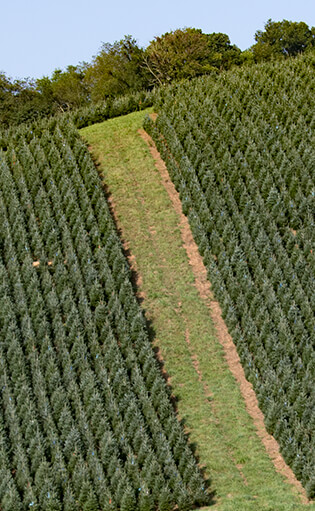Ashe County Christmas Trees
- Ashe County is the largest Christmas tree producing county in the United States.
- Ashe County has approximately 12,000 acres of Christmas trees in production amounting to approximately 20 million trees.
- Ashe County Christmas tree farms help drive the local economy, providing over 700 local jobs year round and over 2,000 jobs during the tree harvest season.
- Trees and greenery contributes more than $85 million annually to the Ashe County economy.
- Since 2000, Christmas trees have seen a 75% reduction in pesticide active ingredient use per acre.
- The average eight foot Christmas tree is 10-12 years old.
- Fraser fir are native to North Carolina.
- All Christmas trees in Ashe County are produced on family farms.
- Christmas trees in Ashe County provide enough daily oxygen for 216,000 people.
- Ashe County has sent more Christmas trees (7) to the White House than any other county in the United States.
Growing Fraser fir Christmas trees in Ashe County
- Growers collect cones in late summer during the years that produce a good cone crop. Cones are dried and then the seed is extracted and cleaned.
- A bushel of cones yields 2-3 pounds of seed with 60,000 seed per pound. Seeds can be frozen to use in the years that do not have a good cone crop.
- Fraser fir puts on one flush of growth each year.
- In the first growing season, a Fraser fir seedling only grows 1-inch tall.
- When a Fraser fir seedling is 6-inches tall, it is replanted in a new bed or larger container to grow two more flushes before being planted in the field.
- To prep ground for planting, growers cut trees, mow weeds, apply lime and fertilizer, disk it in, and possibly sow a ground cover. On the steeper mountain sides, all work is done by hand.
- Some Fraser fir transplants can be planted with a mechanical planter pulled by a four-wheel drive tractor, but because of the mountainous terrain in Ashe County (preferred by the Fraser fir), many transplants are hand-planted. However they are set, all transplants have to be heeled into place by hand and foot.
- Most growers set about 1,600 trees to an acre.
- Healthy transplants tend not to grow much the first year or two until roots become established.
- Each year, growers analyze the soil to determine whether fertilizer or lime is needed for the trees to grow healthy and strong. Fertilizer and lime is added by hand.
- Growers must manage ground cover and weeds in the field every year. Unmanaged grass will choke and kill young trees.
- Growers regularly scout for pests to see what problems may be developing. Scouting happens in the spring, summer, and fall.
- Trees are trimmed or sheared every year. Initially, only the tops may need pruning, but as the tree gets older the sides are sheared with a long knife.
- The way a tree is sheared or trimmed varies from farm to farm. Some growers prefer a tight trim while other prefer a tree that is loose and open.
- Most trees are harvested in 3-6 weeks starting the first week of November. Trees are cut, carried from the field, baled by machine, hauled to a loading yard or storage area, and sorted by size.
- From the storage area or loading yard, trees are loaded onto tractor trailers. Most farms load and stack trees by hand. Some farms palletize the trees and use a forklift to load them onto the truck.
- Most trees are handled 6 or 7 times between being cut and being loaded onto a tractor trailer.
- Usually, no more than 600 to 800 trees fit on a full-size tractor trailer.
- Most farms load dozens of trucks but larger farms may load hundreds in the space of two to three weeks.
For more information about growing Christmas trees, you can visit the North Carolina Christmas Tree Association or the NCSU Extension Christmas Tree Program.


